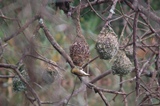Weaver news
| Schultz A, Underhill LG, Earle RA, Underhill G. 2010. Infection prevalence and absence of positive correlation between avian haemosporidian parasites, mass, and body condition in the Cape Weaver Ploceus capensis. Ostrich 81: 69-76 Abstract. Over a two-year period, 945 adult Cape Weavers Ploceus capensis were mist-netted with a bias towards 632 male and 308 female birds. Blood smears presented avian haemosporidia in 58.79% of males and 61.90% of females, representing five species from three genera: one avian kinetoplastid haemoflagellate Trypanosoma everetti with 0.28% infection rate, Haemoproteus queleae (69.45%), Leucocytozoon bouffardi (23.91%), and Plasmodium species (5.76%). Double infections occurred in 40 birds (11.52%), with females having the greatest number. Differences in infection prevalence between sexes was correlated to time spent being active at the nest, with a marked reduction in female infection due to incubation within a tunnel-shaped nest providing protection from vectors. Commencement of the breeding season coincided with increased parasite prevalence in both sexes, correlating to energy expenditure on reproductive effort, resulting in reduced immunocompetence. Recorded seasonal spring relapse is synchronised with peak breeding season activity, when vector intensity and activity peak due to host population increases, and avian immunodefence systems are possibly compromised due to the stress of the reproductive cycle. No negative impacts were discerned on body mass or condition during this long-term study, which may be presented when parasitemia peaks over a number of days only, thereafter decreasing in intensity. Literature as featured in Weaver Watch news items |










